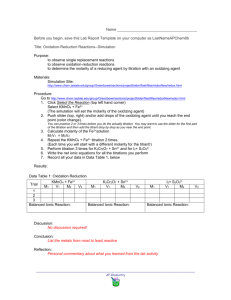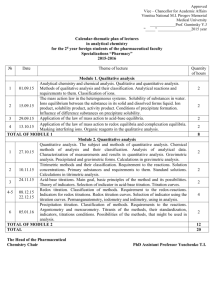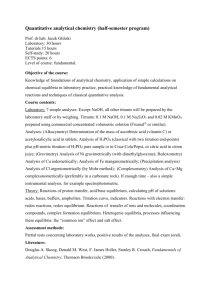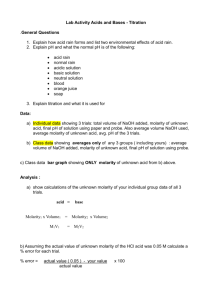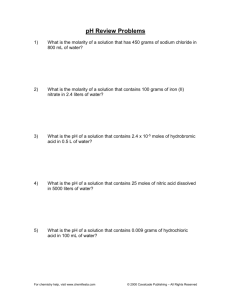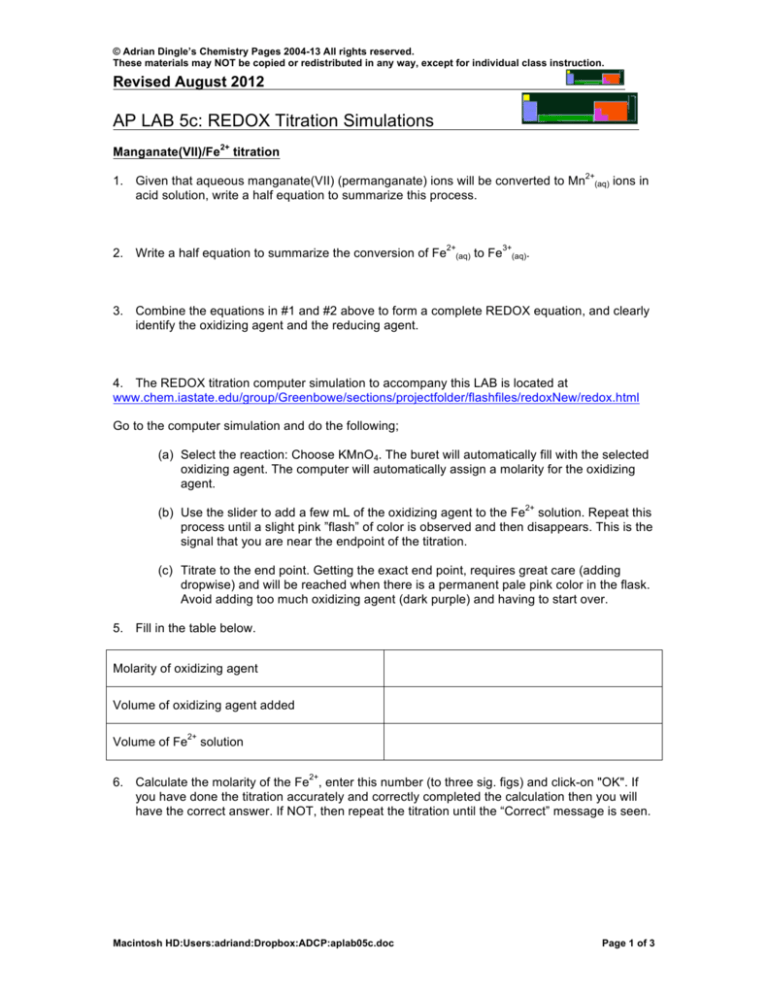
© Adrian Dingle’s Chemistry Pages 2004-13 All rights reserved.
These materials may NOT be copied or redistributed in any way, except for individual class instruction.
Revised August 2012
AP LAB 5c: REDOX Titration Simulations
Manganate(VII)/Fe
2+
titration
1. Given that aqueous manganate(VII) (permanganate) ions will be converted to Mn
acid solution, write a half equation to summarize this process.
2. Write a half equation to summarize the conversion of Fe
2+
(aq)
to Fe
3+
2+
(aq)
ions in
(aq).
3. Combine the equations in #1 and #2 above to form a complete REDOX equation, and clearly
identify the oxidizing agent and the reducing agent.
4. The REDOX titration computer simulation to accompany this LAB is located at
www.chem.iastate.edu/group/Greenbowe/sections/projectfolder/flashfiles/redoxNew/redox.html
Go to the computer simulation and do the following;
(a) Select the reaction: Choose KMnO4. The buret will automatically fill with the selected
oxidizing agent. The computer will automatically assign a molarity for the oxidizing
agent.
2+
(b) Use the slider to add a few mL of the oxidizing agent to the Fe solution. Repeat this
process until a slight pink ”flash” of color is observed and then disappears. This is the
signal that you are near the endpoint of the titration.
(c) Titrate to the end point. Getting the exact end point, requires great care (adding
dropwise) and will be reached when there is a permanent pale pink color in the flask.
Avoid adding too much oxidizing agent (dark purple) and having to start over.
5. Fill in the table below.
Molarity of oxidizing agent
Volume of oxidizing agent added
Volume of Fe
2+
solution
2+
6. Calculate the molarity of the Fe , enter this number (to three sig. figs) and click-on "OK". If
you have done the titration accurately and correctly completed the calculation then you will
have the correct answer. If NOT, then repeat the titration until the “Correct” message is seen.
Macintosh HD:Users:adriand:Dropbox:ADCP:aplab05c.doc
Page 1 of 3
© Adrian Dingle’s Chemistry Pages 2004-13 All rights reserved.
These materials may NOT be copied or redistributed in any way, except for individual class instruction.
Revised August 2012
I2/Thiosulfate titration
2-
7. Given that aqueous thiosulfate (S2O3 ) ions will be converted to S4O6
write a half equation to summarize this process.
2-
(aq)
ions in an oxidation,
8. Write a half equation to summarize the conversion of Iodine to Iodide ions.
9. Combine the equations in #7 and #8 above to form a complete REDOX equation, and clearly
identify the oxidizing agent and the reducing agent.
10. The REDOX titration computer simulation to accompany this LAB is located at
www.chem.iastate.edu/group/Greenbowe/sections/projectfolder/flashfiles/redoxNew/redox.html
Go to the computer simulation and do the following;
(a) Select the reaction: Choose I2. The buret will automatically fill with the thiosulfate
solution. The computer will automatically assign a molarity for the Iodine solution.
(b) Use the slider to add a few mL of the thiosulfate solution to the I2 solution. Repeat
this process until a blue color is observed. This is the signal that the starch indicator
has been added and that you are near the endpoint of the titration.
(c) Titrate to the end point. Getting the exact end point, requires great care (adding drop
wise) and will be reached when there is no longer a blue color in the flask.
11. Fill in the table below.
Molarity of the iodine solution
Volume of iodine solution
Volume of thiosulfate added
12. Calculate the molarity of the thiosulfate, enter this number (to three sig. figs) and click-on
"OK". If you have done the titration accurately and correctly completed the calculation then
you will have the correct answer. If NOT, then repeat the titration until the “Correct” message
is seen.
Macintosh HD:Users:adriand:Dropbox:ADCP:aplab05c.doc
Page 2 of 3
© Adrian Dingle’s Chemistry Pages 2004-13 All rights reserved.
These materials may NOT be copied or redistributed in any way, except for individual class instruction.
Revised August 2012
Dichromate(VI)/Sn
2+
titration
13. Given that aqueous dichromate ions will be converted to Cr
a half equation to summarize this process.
3+
(aq)
ions in an acid solution, write
14. Write a half equation to summarize the conversion of aqueous Tin(II) ions to aqueous Tin(IV)
ions.
15. Combine the equations in #13 and #14 above to form a complete REDOX equation, and
clearly identify the oxidizing agent and the reducing agent.
16. The REDOX titration computer simulation to accompany this LAB is located at
www.chem.iastate.edu/group/Greenbowe/sections/projectfolder/flashfiles/redoxNew/redox.html
Go to the computer simulation and do the following;
(a) Select the reaction: Choose K2Cr2O7. The buret will automatically fill with the
dichromate(VI) solution. The computer will automatically assign a molarity for the
oxidizing agent.
(b) Use the slider to add a few mL of the dichromate(VI) solution to the Sn
2+
solution.
(c) Titrate to the end point which is a pale green color. Getting the exact end point,
requires great care (adding drop wise).
17. Fill in the table below.
Molarity of the dichromate(VI) solution
Volume of dichromate(VI) solution added
Volume of Sn
2+
solution
2+
18. Calculate the molarity of the Sn solution and enter this number (to three sig. figs) and clickon "OK". If you have done the titration accurately and correctly completed the calculation then
you will have the correct answer. If NOT, then repeat the titration until the “Correct” message
is seen.
Macintosh HD:Users:adriand:Dropbox:ADCP:aplab05c.doc
Page 3 of 3

